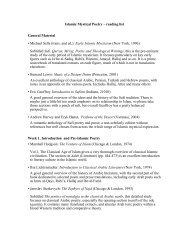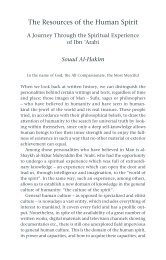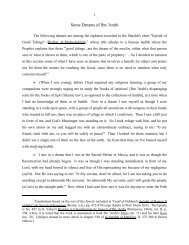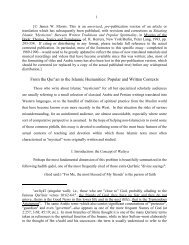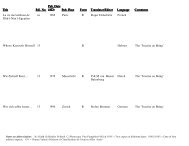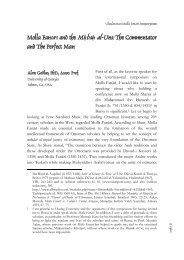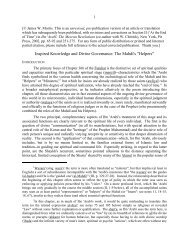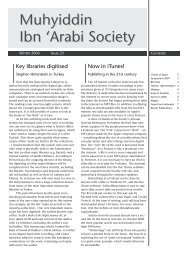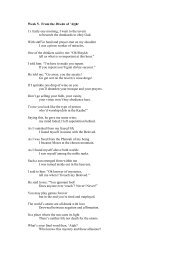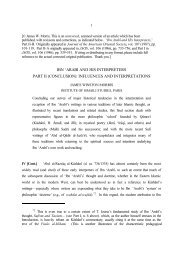Newsletter 22 - Muhyiddin Ibn Arabi Society
Newsletter 22 - Muhyiddin Ibn Arabi Society
Newsletter 22 - Muhyiddin Ibn Arabi Society
Create successful ePaper yourself
Turn your PDF publications into a flip-book with our unique Google optimized e-Paper software.
“Time and Non-Time” in New YorkReport by Jane Carroll on the <strong>Society</strong> Symposium in 2005<strong>Muhyiddin</strong><strong>Ibn</strong> ‘<strong>Arabi</strong> <strong>Society</strong>In October the <strong>Ibn</strong> ‘<strong>Arabi</strong> <strong>Society</strong> of Americaleft the leafy glades of Berkeley, Ojai and Seattle,where recent symposia have been held, and headedacross the country to the heart of New York Citywhere the 2005 symposium was held on the campusof Columbia University. The hustle and bustleof the busiest city in America was exhiliarating,exhausting or both depending on the dispositionof the attendee. But whatever the surroundings,the talks this year were exceptional. 2005 beingthe year of Einstein, and the centenary year of thepublications which shattered previous conceptsof time in the West, many correspondences werefound between <strong>Ibn</strong> ‘<strong>Arabi</strong>’s thought and the findingsof modern physics although it was repeatedlypointed out that <strong>Ibn</strong> ‘<strong>Arabi</strong>’s value transcends thesecorrespondences.Caner Dagli opened the Symposium with histalk “Levels of the Soul and the levels of Time”describing various models of time from the medievalgeocentric cosmology of <strong>Ibn</strong> ‘<strong>Arabi</strong>’s era to theperiod of Newtonian physics and classical mechanicsto the New Physics in which the scientist makesno absolute statement about what we can know.This has had the paradoxical effect of returning thehuman to an understanding of the world based onhis real experience.For <strong>Ibn</strong> ‘<strong>Arabi</strong> who asserts that time and spacehave no essential reality but are modes of revelationof the eternal unchanging Self, the spiritualjourney consists of aligning the self which experiencestime and movement, with the non-temporalself so that the former can be transfigured by thelatter.Ibrahim Kalin continued the theme of “experienced”time in his paper, “Temporal and EternalTime in <strong>Ibn</strong> ‘<strong>Arabi</strong> and Mulla Sadra”. The modernconcept of time as an even continuum which canbe measured by a clock denies our experience of itsdifferent qualities. Both <strong>Ibn</strong> al-‘<strong>Arabi</strong> and Mulla Sadraspeak of time (zaman) as subjective and “imaginary”the experience of which alters according tostate. The “Eternal Now” is the essential reality ofthe changing things and the path of the sufi is thepreparation of the soul for participating in this.Alison Yiangou’s talk ““There’s no Time likethe Present” dealt with the matter from the humanperspective. As each instant is a “coming intobeing” of the singular ever present Reality in one ofthe forms of its possibilities, from our point of viewthis instant is the gift, or present, of existence inthe form of our own possibility. We are necessarilyan image of our time and our time is an image ofus. In both senses of the word, there is literally nobetter time than the present.In the early evening Rafi Zabor read from hisjust published book “I Wabenzi” a section relatingto his first studies of <strong>Ibn</strong> ‘<strong>Arabi</strong> in the early 70’sand also a section describing his own experienceof a timeless moment in attempting to practise theMevlevi turn. To hear the description of a personalexperience of time and timelessness so convincinglyrendered provided an original end to the day.On Sunday morning Jaakko Hämeen-Anttiladelivered a paper on “Ayan thabita and <strong>Ibn</strong> ‘<strong>Arabi</strong>”.He suggested that <strong>Ibn</strong> ‘<strong>Arabi</strong>’s concept of time asan organising principle between events having noexistence in itself corresponds in many respects tomodern physic’s view of time as a fourth dimension.The changing things of this world whosereality is the ayan thabita or immutable entitiesare analogous to modern scientists’ description ofthings moving through time and space in spacetimeworms.Gerald Elmore’s paper “The Sun of ReligionMeets its ‘Reviver’?” was a speculation on therelationships between Shams-i Tabrizi, and byextension Rumi, and <strong>Ibn</strong> ‘<strong>Arabi</strong>. The possible connectionsin time and space of these great saintsand their differing but complementary legacies wasexplored in history and legend. Given the theme ofthe symposium, their connection outside of timewas shown to be indisputable.Stephen Hirtenstein completed the symposiumwith a paper entitled “The Mantle of Khadîr,mystery, myth and meaning” which extracted <strong>Ibn</strong>‘<strong>Arabi</strong>’s writings on Khidr, his interpretations of hismeaning and his descriptions of his own encounterswith him. <strong>Ibn</strong> ‘<strong>Arabi</strong> tells us that at the levelof Khidr, which he calls the Station of Closeness,is a prophethood which is fundamentally esoteric,unconditioned by people, place and time. It wasentirely appropriate that this symposium shouldconclude with a description of a guidance to theinner reality of man from a station unconstrainedby time.“Know Yourself”Berkeley, California - October 14-15, 2006The <strong>Ibn</strong> ‘<strong>Arabi</strong> <strong>Society</strong> in the USA will holdits Annual Symposium at the Faculty Club, Universityof California at Berkeley on October 14th and15th, 2006.The speakers include Samer Akkach (Universityof Adelaide, Australia), Suleyman Derin (MarmaraUniversity, Istanbul), Olga Luchakova (Instituteof Transpersonal Psychology, San Francisco), JimMorris (Boston College), Elizabeth Roberts (BesharaSchool, Scotland), Omid Safi (University of NorthCarolina), Laury Silvers (Skidmore College).The programme and registration form will beposted on the <strong>Society</strong> web site.



